With Google looking at over 200 factors when ranking a website, how do you know which ones to focus on?
Or better yet, what steps do you need to take in order to improve your rankings?
In order to help you with your on-page optimization, let’s get started with an infographic we created that shows you how to make each of your web pages search-engine-friendly.
Let’s begin.
As you can see there are many factors involved in creating a perfectly optimized page. On-page optimization can go to a deeper level than just making sure your meta tags are filled out. And you can go to that deeper level without having to be a veteran SEO.
Here’s how:
Tactic #1: Search for synonyms using Google
The use of synonyms in creating an SEO plan for your blog or website is pretty common. Finding those synonyms, however, is not always easy or is done properly.
We think the best way to search for these terms is to use Google. The reason for that is that you get to see not only the synonyms themselves but also how they are ranking in competitors’ pages.
To search for synonyms on Google, simply put the tilde symbol (~) before your search term. Here’s what it looks like if we search for synonyms using “~small budget marketing.”
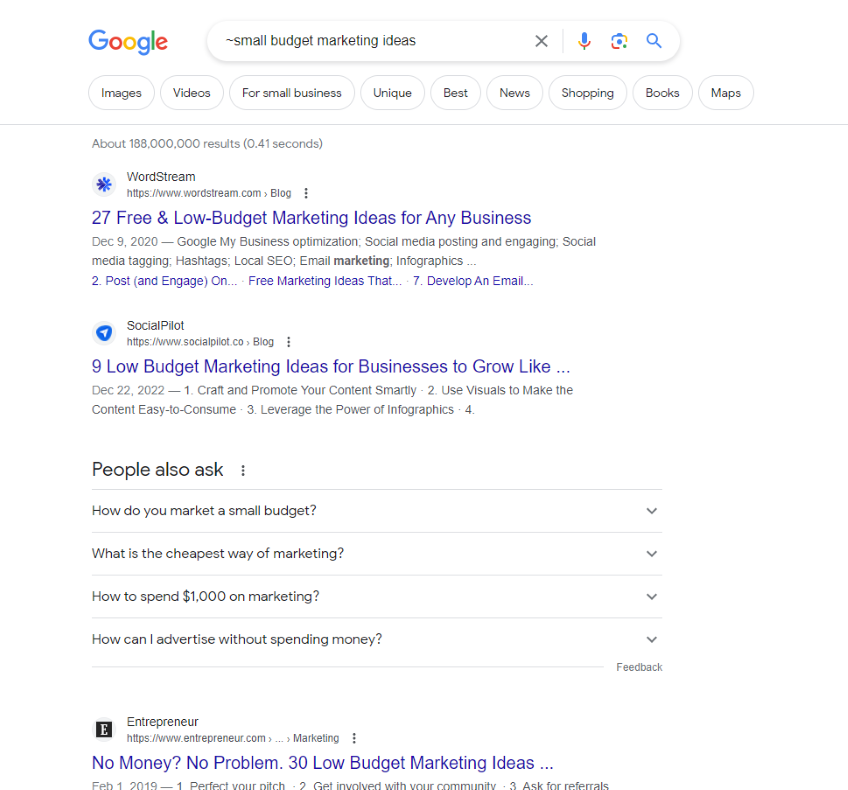
This is actually how we looked up the terms we used in the internal links section to find synonyms for my web page.
If you want to look up synonyms without the phrase in the results, do this: “~ + phrase – phrase.”
This will give you synonyms without returning back your original search phrase. You can then take these keywords and integrate them within your copy, wherever it flows smoothly and organically. By using synonyms within your content, you’ll notice that you start ranking your website for more relevant long tail keywords.
Tactic #2: Link to high authority sites
We all know that links from high authority sites are important. They tell the search engines that your site can be trusted because a high authority site is linking to it.
What is a high authority site? They are the information/content sites like Boing Boing, CNN, Drudge Report or Huffington Post. There are also other forms of content sites like .edu and .gov sites.
A link from these sites tells search engines that you can be trusted. But did you know that an external link going out to these high authority sites can boost your SEO?
When search engines crawl your site, see a link and follow it to CNN or Huffington Post, they weigh it as a positive. The trick is to find organic ways to link to these sites, like we did in this post.
Adding them into an anchor text will make them even more natural. For example, if “getting a link from CNN can crash your servers” was a link, with that link going to the specific CNN page, that would be a very natural external link.
By adding these authority links to your website, you will show search engines that your website can be related to these high authority sites.
Tactic #3: Pay attention to sentiment search signals
The idea of search engines paying attention to the mood, emotions and attitudes of web content can’t be ignored.
What exactly is sentiment?
If I get to a page about a motorcycle part, and I am like, “God, not only is this well written, it’s kind of funny. It’s humorous. It includes some anecdotes. It’s got some history of this part. It has great photos. Man, I don’t care at all about motorcycle parts, and, yet, this is just a darn good page.
What a great page. If I were interested, I’d be tweeting about this, I’d share it. I’d send it to my uncle who buys motorcycles. I would love this page.” That’s what you have to optimize for. It is a totally different thing than optimizing for Did I use the keyword at least three times? Did I put it in the title tag? Is it included in there? Is the rest of the content relevant to the keywords?
So, if you want to produce healthy results, here are some things you can do:
- Reviews – Search engines are looking at product reviews to gauge the feeling of the content plus all of the on-page content. This means, however, that large response to content, whether by actual recommendations or a vote, will carry more weight. This may seem out of your control, which it is, but in reality you can use this information to make your product or content better.
- Content – Stay on top of the ever-changing landscape of what search engines view as relevant content. For example, for the longest time, searchable content was limited to text. That’s beginning to change as search engines are discovering ways to define video content.
- Context – Search engines are also learning how to figure out the meaning of content by its environment, asking questions like “Was the response to the video positive or negative?” “Were the tweets in response to the video good or bad?”
- Personality – You must make the content on the page feel as if a funny warm-blooded human being wrote it. Or someone who is constantly angry. In other words, it must show it was written by a likable person, and not a machine.
This technique is pretty advanced and does require sentiment analysis software.
Tactic #4: Give Google fresh content on a web page
We know that search engines like fresh content. And we know that pushing out fresh content on a daily basis builds traffic and drives leads to our door. That’s why we spend so much time creating new blog posts.
But don’t forget about the fresh content on a single page. That in itself is a signal to search engines that you’ve updated a page, and quite possibly will continue to update the page, so they’ll visit more often.
And the more they visit, the more trust you get and, hopefully, the higher rankings to go along with that. If you don’t update often, the spiders will extend the time between visits.
Just take a look at Wikipedia…Its entries dominate the rankings. Most of its pages are updated frequently.
Another thing you can do is include a Twitter update on your home page. Or a list of recent comments or the top commenters:
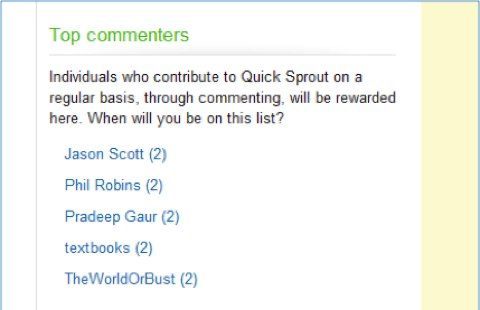
The popular posts widget can do the trick too:
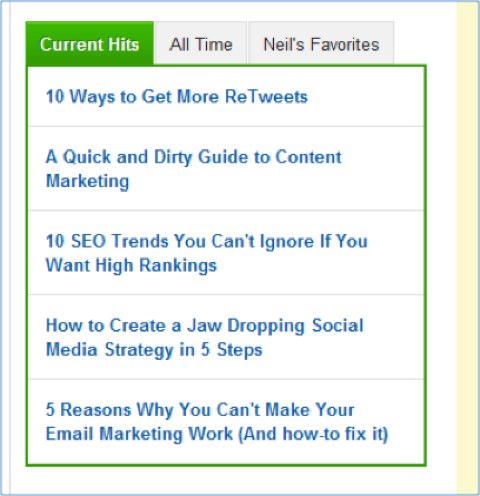
For non-home pages, you can freshen up the content by adding to the story through updates, more statistics, a growing portfolio of projects, case studies or even comments.
You can do this by identifying a handful of your strong link-worthy pages and then mapping out a strategy to update them on a regular basis. You should try to update these pages at least a few times a month.
Tactic #5: Use Dublin Core metadata elements
The jury is still out on whether and how much search engines give weight to keywords in metadata. Most experts agree that you should add keywords to your metadata, just in case.
And it is important that your keywords match throughout your metadata, from title to description, in order not to get punished. It’s the same with using Dublin Core metadata.
Dublin Core is an open source movement started in Dublin, OH. It is created to help prepare content for discovery for the future of the web, namely the semantic web.
The benefit of using Dublin Core metadata, the theory goes, is that maybe search engines look at this code as an extra step that the content creator is taking to make his or her content as relevant as possible to a particular search.
The other benefits of Dublin Core include the following:
- It can help with some internal search engines.
- It can help with your SEO efforts.
- It is easy to implement.
- It does not bloat your code.
To install Dublin Core metadata into your website is easy. You place it in the HTML header of your page, i.e., within the <head>, right after you add the normal HTML data.
Here’s what it looks like:
<head>
<link rel=”schema.DC” href=”https://purl.org/dc/elements/1.1/”>
<meta name=”DC.title” content=”SEO with Dublin Core”>
<meta name=”DC.description” content=”How to embed Dublin Core metadata in a web page to provide a standards-based approach to search engine optimization (SEO) that complements HTML metadata.”>
<meta name=”DC.subject” content=”seo dublin core, seo dublin core tips, search engine optimization with dublin core”>
<meta name=”DC.language” scheme=”ISO639-1″ content=”en”>
</head>
If you want help adding it to XML and XHTML code, head to the SEO with Dublin Core page. By the way, you should test your SEO efforts against a baseline to determine whether there are any benefits to using Dublin Core on your site. Don’t just take our word for it.
Tactic #6: Define content absolutely
If you do a search for “Dublin Core,” the first four search results are for dublincore.org. The fifth is for Wikipedia.
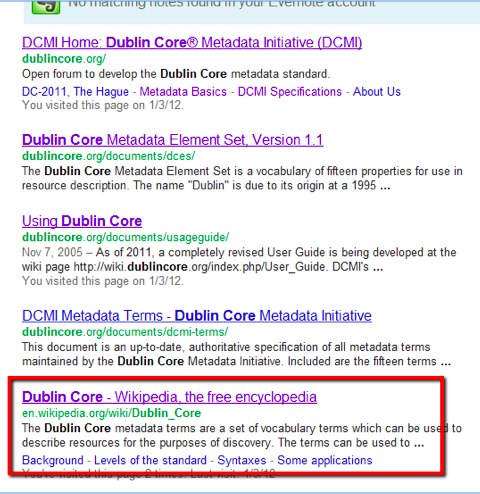
If you do a search for “meta data,” the Wikipedia entry is at the top.

Search for the word “strategy,” and the top five results have one Wikipedia and two dictionary entries:
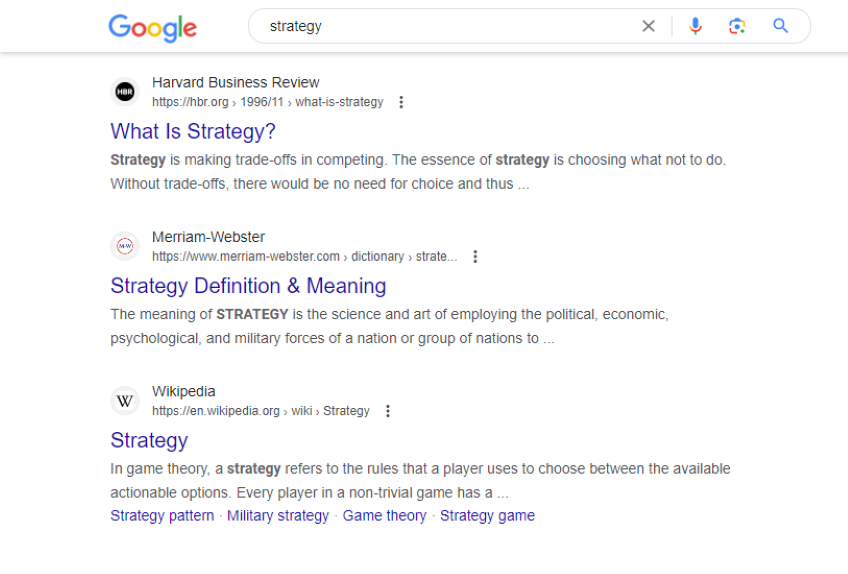
This simple little demonstration shows you what’s called “relevance authority.” Search engines view these sites and their pages for the keywords as dead-on matches for the keywords.
Why is that?
It’s because the entire page is geared to defining the keywords. The lesson for you is to get into a habit of creating pages that “define” keywords like authority sites like Dictionary.com and Wikipedia does.
It will be difficult to compete against these authority sites with competitive terms, but with less competitive terms, it will be easy to rank high.
Conclusion
Using these on-page optimization tactics will give your current tactics a boost and help you gain better rankings in the search engines. So, give them a try. They are actually pretty easy to implement.
The biggest mistake we see companies make is mess up their URL structure. If you are strapped for time, focus on fixing that first. It’s one of the hardest things to fix, but it will pay off in the long run.
The rest can be fixed over time, and it isn’t as complicated. For example, improving load time can be done with the help of Google PageSpeed.
